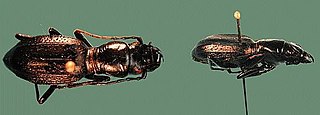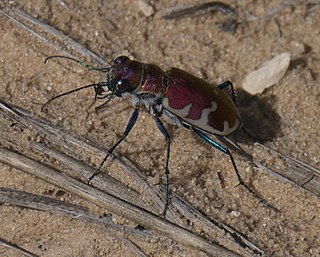
Tiger beetles are a family of beetles, Cicindelidae, known for their aggressive predatory habits and running speed. The fastest known species of tiger beetle, Rivacindela hudsoni, can run at a speed of 9 km/h, or about 125 body lengths per second. As of 2005, about 2,600 species and subspecies were known, with the richest diversity in the Oriental (Indo-Malayan) region, followed by the Neotropics. While historically treated as a subfamily of ground beetles (Carabidae) under the name Cicindelinae, several studies since 2020 indicated that they should be treated as a family, the Cicindelidae, which are a sister group to Carabidae within the Adephaga.

Amblycheila cylindriformis is a species of flightless tiger beetle. It shares its genus with at least five other species in the United States, with a few more found in Mexico.

Omus dejeani is a species of flightless tiger beetle (Cicindelidae) that is found from British Columbia almost to northern California in dense, coastal forests. It is the largest species of the genus, at between 15 and 20 mm.

Omus is a genus of tiger beetles, subfamily Cicindelinae. Its members are dark colored, nocturnal, and flightless. All members occur along the west coast of North America.

Cicindela hirticollis is a species of tiger beetle that is commonly found in sand bars and sandy beaches of North America. It is medium-sized, is about 2–14 mm (0.08–0.55 in) long, and is active in the summer. The dorsal surfaces of the head, prothorax, and elytra are dark brown. The elytral markings are very light-colored cream or white. The species' common names are hairy-necked tiger beetle and moustached tiger beetle. Its population is in decline.

Protocollyris is a genus of tiger beetles in the family Cicindelidae, tribe Collyridini.
Neocollyris pacholatkoi is a species in the tiger beetle family Cicindelidae. It was described by Sawada and Wiesner in 2006 and is endemic to India.
Amblycheila picolominii is a species of nocturnal tiger beetle in the genus Amblycheila. Its common name is the plateau giant tiger beetle. It was discovered in 1839.
Amblycheila hoversoni, also known as the South Texas giant tiger beetle, is a flightless and nocturnal tiger beetle species found in south and west-central Texas, United States. First described in 1990, it is the largest tiger beetle species in the Western Hemisphere.

Amblycheila schwarzi, also known as the Mojave giant tiger beetle, is a flightless and nocturnal tiger beetle species found in the southern United States. A. schwarzi was first described by German entomologist Walther Horn in 1904.

Cicindelini is a tribe of tiger beetles in the family Cicindelidae, containing the overwhelming majority of genera and species in the family. There are more than 90 genera and 2,000 described species in Cicindelini.
Cicindela limbata, the sandy tiger beetle, is a species of flashy tiger beetle in the family Cicindelidae. It is found in North America.

Cicindela fulgida, known generally as the crimson saltflat tiger beetle or shiny tiger beetle, is a species of flashy tiger beetle in the family Cicindelidae. It is found in North America.

Cicindela scutellaris, the festive tiger beetle, is a species of flashy tiger beetle in the family Cicindelidae. It is found in North America.

Cicindela longilabris, the boreal long-lipped tiger beetle, is a species of flashy tiger beetle in the family Cicindelidae. It is found in North America.

Cicindela formosa, the big sand tiger beetle, is a species of flashy tiger beetle in the family Cicindelidae. It is found in North America.

Collyridini is a tribe of tiger beetles found mostly in Asia.

Manticorini is a tribe of tiger beetles in the family Cicindelidae. There are about 6 genera and more than 30 described species in Manticorini.

Oxycheilini is a tribe of tiger beetles in the family Cicindelidae. There are at least 3 genera and more than 70 described species in Oxycheilini.
Ctenostomatini is a tribe of tiger beetles in the family Cicindelidae. There are at least two genera and more than 230 described species in Ctenostomatini.














